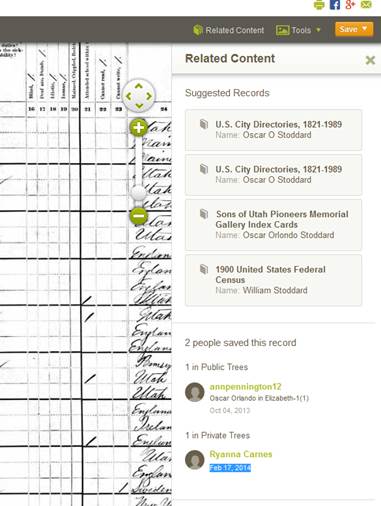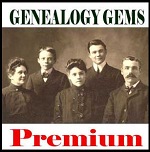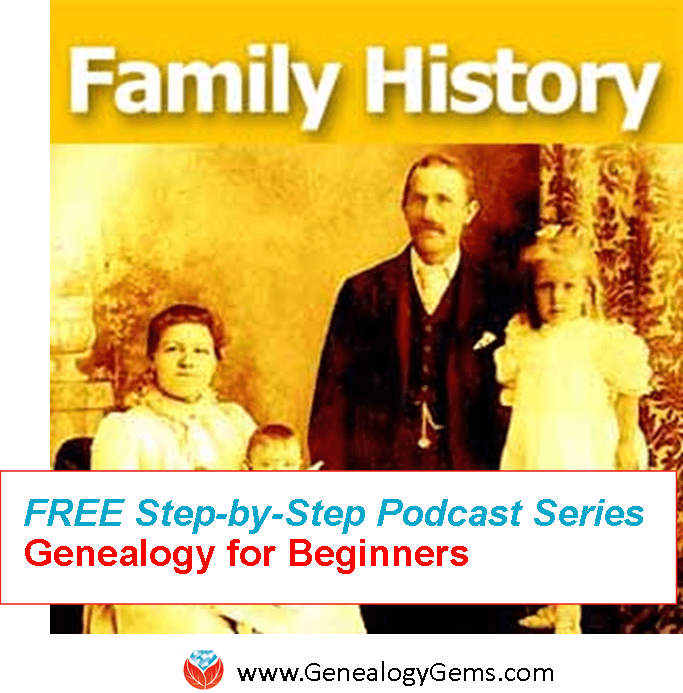by Lisa Cooke | Sep 30, 2014 | 01 What's New, Ancestry, Census, Collaborate
 There are lots of ways to find historical records about your ancestors online. Did you know there are also ways to learn who else has added that record to their trees–or who else is researching the same people you are? Here are two ways:
There are lots of ways to find historical records about your ancestors online. Did you know there are also ways to learn who else has added that record to their trees–or who else is researching the same people you are? Here are two ways:
1. On Ancestry.com, when you are looking at an image of a record, there’s a sidebar to your right called “Related Content.” Click on it. Below other suggested records you will see a list showing anyone who has saved this record to their trees. You’ll see a link to that username and you can contact them. This is what it looks like:  2. On LostCousins.com, you can enter the names of relatives whose names appear on specific censuses. Their database will search for others who are looking for the same people. This is a great resource for people with British Isles roots, as the site originates from there. Here are the censuses they support:
2. On LostCousins.com, you can enter the names of relatives whose names appear on specific censuses. Their database will search for others who are looking for the same people. This is a great resource for people with British Isles roots, as the site originates from there. Here are the censuses they support:
- England and Wales, 1841, 1881, 1911
- Scotland, 1881
- United States, 1880, 1940
- Canada, 1881
- Ireland, 1991.
Basic membership at LostCousins.com is free, but has limited functionality. You can only contact new people during certain windows of time during the year. With a £10 annual subscription, you can make new contacts anytime.  Looking for more ways to find living relatives? Genealogy Gems Premium members can click here to access my full-length video class, Unleash Your Inner Private Eye to Find Living Relatives. Not a member? Click here to join.
Looking for more ways to find living relatives? Genealogy Gems Premium members can click here to access my full-length video class, Unleash Your Inner Private Eye to Find Living Relatives. Not a member? Click here to join.
by Lisa Cooke | May 23, 2014 | 01 What's New, MyHeritage
 MyHeritage has signed on to sponsor The Genealogy Gems Podcast! Their support helps us to continue to bring you free multimedia content to inspire and inform your genealogy journey.
MyHeritage has signed on to sponsor The Genealogy Gems Podcast! Their support helps us to continue to bring you free multimedia content to inspire and inform your genealogy journey.
Our editorial team has spent several months getting to know MyHeritage.com. We think you’ll love their…
International membership. MyHeritage serves over 70 million members worldwide in 40 languages. Did your English-speaking ancestors originate in the British Isles? Are you discovering Sephardic roots in Spain? MyHeritage members may be your cousins—or know something about them. Check out their world membership map here.
24/7 record searching technology. MyHeritage uses a unique and powerful search system called Record Matches to constantly cull 5 billion historical records for your family. It’s the only family history interface out there using semantic analysis to search newspaper articles, books, and other free-text documents. It is also the first to translate names between languages. I personally like that matches from MyHeritage’s historical newspaper collections show up toward the top. It’s a great way to find obituaries!
Millions of trees. MyHeritage can search over 1.5 billion records in their own 27 million trees and recently-acquired Geni.com’s unified tree. From a single screen, members can search all those trees plus WikiTree and other trees. But you don’t even have to search. MyHeritage’s unique Smart Matching technology intelligently matches each family tree to hundreds of millions of profiles in other family trees. Members are alerted when new matches appear on the site.
Offline software companion. Family Tree Builder 7.0 is free software that allows you to keep a master copy of your family tree offline. Read my blog post on that topic here.
Great app. The MyHeritage app for iPhone, iPad and Android 2.2 helps you research, record and share your family history on the go. You can browse records, photo-share, and show off your tree in its beautiful display.
Genealogy Gems will continue to bring you news and gems on a wide range of genealogy topics and companies, not just MyHeritage. But we do encourage you to get to know MyHeritage.com. We choose our advertisers carefully and are very proud to partner with them!
by Lisa Cooke | Mar 18, 2014 | 01 What's New, Certification, Family History Podcast, Research Skills, Source Citation

Listen to the Family History: Genealogy Made Easy podcast by Lisa Louise Cooke. It’s a great series for learning the research ropes and well as refreshing your skills.
Originally published 2009
Republished March 18, 2014
https://lisalouisecooke.com/familyhistorypodcast/audio/fh23.mp3
Download the Show Notes for this Episode
Welcome to this step-by-step series for beginning genealogists—and more experienced ones who want to brush up or learn something new. I first ran this series in 2008-2009. So many people have asked about it, I’m bringing it back in weekly segments.
Episode 23: The GPS in Action: Using the Genealogical Proof Standard
In episode 20, we talked about using the Genealogical Proof Standard (GPS), the powerful research process used by the professionals. This process ensures the quality, accuracy and success of our research. Researching by these standards now may save you going back and re-doing some of your hard work later down the road.
In today’s episode I’m going to help you put the GPS into concrete action with an example from my own research. And I have some downloadable free tools that will help you do the job! In this episode we also follow up with a listener question on how to export your family tree from Ancestry.com—see below for an updated link.
The GPS in Action
Wouldn’t it be nice to have a worksheet that prompts you through the GPS process and helps you keep track of everything and stay organized? Well, I wanted something like that myself. I think we need more than just a blank form: we need and want a detailed worksheet that not only gives the area to record our findings, but also buy medication online usa incorporates all the key areas of the Genealogical Proof Standard so that we can be sure we aren’t missing anything.
I didn’t find something like this online so I created it myself. Click on the Research Worksheets, under Links below, for both a filled-out sample version and a blank version that you can save to your computer.
According to the Board of Certification of Genealogists the 5 keys elements of the Genealogical Proof Standard are:
- a reasonably exhaustive search
- complete and accurate source citations
- analysis and correlation of the collected information
- resolution of any conflicting evidence
- a soundly reasoned, coherently written conclusion
I’ve incorporated these elements while keep in mind Mark Tucker’s process map worksheet (see Links section below) into my Research Worksheet.
The Research Worksheet is divided into the following sections:
- Research Objective
- Known Facts
- Working Hypothesis
- Research Strategy
- Identified Sources
- Final Conclusions
In your conclusion which is called a Proof Argument you should:
- Explain the problem
- Review the known sources which you identified on your worksheet
- Present the evidence with source citations and the analysis of those sources
- Discuss any conflicting evidence. This important because it may generate another search that needs to occur, or put to rest questions about evidence that on first glance looks conflicting.
- And finally summarize the main points of your research and state your conclusion.
Updates and Links
How to download your GEDCOM from Ancestry.com
Research Worksheet: Example
Research Worksheet: Blank Form
Correspondence Log
Mark Tucker’s GPS Flowchart
by | Feb 21, 2014 | 01 What's New, African-American, Ancestry, History
Many Americans have ancestors who lived through the Civil War: many have roots in both the North and South. Few families, whether they sent soldiers away or not, were untouched by this conflict that claimed an estimated 620,000 lives and freed millions of American men, women and children from slavery.
Ancestry.com recently posted a new video webinar to help you begin tracing buy thrush medication your Civil War ancestors. It’s given by noted genealogist Amy Johnson Crow. Check it out:
Here are some more great online resources for Civil War research:
Do You have a friend who would enjoy this article?
Copy & Paste this address into your email to them:
https://lisalouisecooke.com/2014/02/research-civil-war-ancestors/
by | Mar 20, 2014 | 01 What's New, Newspaper, Records & databases
 More obituaries gleaned from newspapers are going online. This is welcome news for those researching their genealogy.
More obituaries gleaned from newspapers are going online. This is welcome news for those researching their genealogy.
Recently I blogged about BillionGraves’ new Supporting Records feature that allows users to upload documentation relating to ancestors’ deaths. This paves the way for more obituaries to be paired with ancestral tombstones and other resources. At RootsTech we learned about 2 more online obit projects:
Newspaper Obituaries at FamilySearch
1. FamilySearch is spearheading the indexing of millions of obituaries from the U.S., followed by other nations. CEO Dennis Brimhall announced this initiative in his keynote speech at RootsTech. “Estimates claim over 500 million obituaries exist in the U.S. alone,” said Dennis Brimhall, FamilySearch CEO. “The average obituary can contain the names of about ten family members of the deceased—parents, spouse, children, and other relatives. Making them easily searchable online can be an enormous future source for creating our family histories. The number of people who will benefit is incalculable. It could very well be the single largest preservation and access project of its kind, and will no doubt be one of the most used online collections worldwide as it grows.”
The timing of completion depends on volunteer efforts, Brimhall says. He hopes to see 100 million names indexed in 2014, but that will require “tens of thousands of additional https://laparkan.com/buy-prednisone/ volunteers.” (Want to help? Go to FamilySearch.org/indexing.)
Upload Newspaper Obituaries at ObitsAncestry
 2. A new website, ObitsAncestry.com, allows individuals to upload obituaries for free, along with up to 4 related images. The obituary webpage is like the memorial pages hosted by many funeral homes, where loved ones can post comments and memories. But there’s no advertising, so it’s very respectful and “quiet.” Anyone searching for that loved one’s name will find the obituary indexed by major search engines. And perhaps most useful for the future, “All obituaries submitted to ObitsAncestry.com will be indexed and linked by familysearch.org for family history and genealogical purposes.” That gives me a little more confidence in the “staying power” of obituaries I would post there. The site just launched during RootsTech, so their database is growing now.
2. A new website, ObitsAncestry.com, allows individuals to upload obituaries for free, along with up to 4 related images. The obituary webpage is like the memorial pages hosted by many funeral homes, where loved ones can post comments and memories. But there’s no advertising, so it’s very respectful and “quiet.” Anyone searching for that loved one’s name will find the obituary indexed by major search engines. And perhaps most useful for the future, “All obituaries submitted to ObitsAncestry.com will be indexed and linked by familysearch.org for family history and genealogical purposes.” That gives me a little more confidence in the “staying power” of obituaries I would post there. The site just launched during RootsTech, so their database is growing now.

Available at http://genealogygems.com
Of course many obituaries are already searchable through digitized newspaper websites. But the accuracy rate for searching these isn’t as high–I’ve seen it reported it as about 60%. Which is a great start, don’t get me wrong, but I’m so pleased that better searching of obituaries is in the works!
Want to learn more about using newspapers and obituaries in genealogy? Check out Lisa’s book How to Find Your Family History in Newspapers.
 There are lots of ways to find historical records about your ancestors online. Did you know there are also ways to learn who else has added that record to their trees–or who else is researching the same people you are? Here are two ways:
There are lots of ways to find historical records about your ancestors online. Did you know there are also ways to learn who else has added that record to their trees–or who else is researching the same people you are? Here are two ways: 2. On LostCousins.com, you can enter the names of relatives whose names appear on specific censuses. Their database will search for others who are looking for the same people. This is a great resource for people with British Isles roots, as the site originates from there. Here are the censuses they support:
2. On LostCousins.com, you can enter the names of relatives whose names appear on specific censuses. Their database will search for others who are looking for the same people. This is a great resource for people with British Isles roots, as the site originates from there. Here are the censuses they support: Looking for more ways to find living relatives? Genealogy Gems Premium members can click here to access my full-length video class, Unleash Your Inner Private Eye to Find Living Relatives. Not a member? Click here to join.
Looking for more ways to find living relatives? Genealogy Gems Premium members can click here to access my full-length video class, Unleash Your Inner Private Eye to Find Living Relatives. Not a member? Click here to join.




